PinotFile: 8.4 October 29, 2009
|
WesMar: Aromas that Dance in the GlassWesMar Winery is a modest garagiste throwback winery located in the former Vacu-Dry apple processing facility on Gravenstein Highway in Sebastopol. There is no fancy sign to mark the winery, just some grape bins outside with the name “WesMar” stenciled on them, and a few halved stainless steel milk shipping containers used for fermentations that are left over from Williams Selyem winery when it was owned by Burt Williams and Ed Selyem. The Williams Selyem imprint is evident in the winery’s business model and the wines are déjà vu for lovers of the Williams Selyem Pinot Noirs of the early 1990s. This is not surprising, for owner Denise Mary Selyem is the daughter of Ed Selyem, and both her and her partner and spouse Kirk Wesley Hubbard, worked at Williams Selyem for several years before the winery was sold in 1997.
 The owners are an unpretentious couple who shun the limelight. They do not submit their wines for comparative judging, preferring to allow the wines to speak for themselves. It took nine vintages before they ventured out into the Pinot Noir event circuit, pouring their latest releases at the 2009 Pinot Days San Francisco. As a result, WesMar is primarily known to hardcore Pinot Geeks. Wesmar is strictly a two-person winery, with Kirk and Denise sharing all winemaking and winery management duties without the assistance of employees, consultants or brokers. Denise and Kirk have an ongoing good-natured dispute about who has the most winemaking experience, with Denise offering as proof of her superior know how a photo of her and her brother stomping Pasquinelli Zinfandel in 1974. Despite their focus and independent spirit, Denise and Kirk love contact with their consumers and warmly receive visitors by appointment to their 1,500 square-foot winery. They still resist selling their wines on the internet, preferring to deal with their customers directly on a more personal level. I have been a fan of WesMar (pronounced “Wes-Mare”) Pinot Noirs for many years and have introduced many happy Pinot Geeks to the wines. The Pinot Noirs are distinctive for several reasons. First, Denise has an aroma fetish, often smelling her wines for extended periods (“devouring the nose” as she puts it”). The ultimate compliment for a Pinot Noir, she says, “Is an aroma that dances in the glass.” Second, the wines show a remarkable consistency from vintage to vintage, regardless of vineyard source. I have been drinking WesMar Pinot Noir for seven years and have never had a disappointing bottle. Third, each of their yearly bottlings are distinctive. Denise and Kirk realize that people tend to gravitate toward that which is familiar and look for similarities in wines from different sources. From a winemaker’s prospective, the desire is always there to replicate the success that a particular vineyard or vintage may offer. To counter this tendency, Denise and Kirk strive to make wines that have individual personalities, yet offer very similar levels of richness. Denise refers to these distinct terroir-driven differences as “WesMarrior.” I have spoken a number of times with Denise and Kirk about their winemaking regimen. I am certain that the intoxicating aromatics, irrepressible flavors and attractive textures consistently achieved in WesMar Pinot Noirs are from intuition, experience, a deft touch, and hands-on, labor-intensive commitment every step of the way. There is a close eye on detail and a judicious monitoring of barreled wines that is only possible in a small winery of this design where two control freaks can be proactive rather than reactive. Grapes are picked earlier than many producers because of the belief that the feminine aspects of Pinot Noir are best expressed at lower sugar levels. If grapes are picked over several days, the incoming grapes are never added to the existing must, but rather fermented separately. Each vineyard is treated to the same fermentation regimen. No cold soaks are used, although when the fruit arrives at the winery, the grapes in their own tank juice are inoculated with proprietary yeast and usually the fermentation does not begin for two days. Five ton, double-walled, rectangular open-top stainless steel milk shipping containers are used for fermentations to maximize surface area relative to height and width. All punch downs are by hand. Portable glycol heaters maintain complete temperature control. Whole cluster, ranging from 20% to 40% is used, depending on a number of factors. The thinking is that whole cluster provides some aroma and flavor nuances and age ability, but significant whole cluster inclusion should be avoided because it can detract from early drink ability that most consumers demand. Fermentations are short by Pinot Noir industry standards, lasting from 7 to 10 days. Pressing is carried out with an old incarnated bladder press once used for apples. Aging is carried out in 50% to 70% new Francois Freres oak barrels for 11 months. The entire winemaking process is by gravity flow (WesMar owns no pumps). Fining and filtering are unnecessary because the wines are lovingly tendered in small lots and constantly monitored for stability. No flavor nuances are ever squandered by manipulation or intervention.
 Asked to describe the WesMar “style,” Denise touts, “Aromatic, fruit-forward, not excessively ripe, balanced acidity, complimentary fruit tannins, subtle oak impressions, richness of flavors, finishing with a cloying mouth feel and flavors that linger long after the wine has left the mouth.” In other words, as the WesMar tag-line says, “Palate Pleasing Pinot Noir.” Each year, the WesMar Pinot Noirs are released on Valentine’s Day. I recently tasted the lineup of 2007 WesMar Pinot Noirs, released Valentine’s Day, 2009. 2007 offered a perfect growing season and Kirk and Denise were very pleased with the quality of the grapes. Because of early bud break, the clusters had ample hang time to fully develop. Clusters were on the small size, contributing to concentrated flavors. The vintage compares to 2005, but with more fruit concentration and structure. Flavors were noticeably precocious when Kirk and Denise sampled from the fermenting tanks. As they were free running (siphoning via gravity) the just-fermented juice wine from fermentation tank to barrel, they thought, “For a very young wine lacking the influence of oak, this tastes surprisingly like a finished wine.” During barrel tastings, they remarked, “This tastes like it could be bottled right now.” Kirk and Denise say, “This is the most exciting vintage with which we have worked. Remember, we are suckers for wines with vibrantly feminine fruit flavors and low alcohols!” My experience has been that the WesMar Pinot Noirs will age perfectly fine for at least six years, and even longer in large format. WesMar is one of the minority of Pinot Noir producers who release most of their bottlings in magnum format. Wines in magnums can be expected to age 10 to 15 years. Unlike most producers who add an extra charge for magnums, WesMar magnums are twice the 750 ml bottle price. The 2007 lineup of WesMar Pinot Noirs are stunning wines, the best vintage ever for this producer. Every wine has impeccable balance, never leading you to think tannin, acid, or oak upon tasting. All have a purity of fruit expression that is striking. Visit the website at www.wesmarwinery.com for Kirk and Denise’s tasting notes. The wines are sold primarily through a mailing list. The prices are very fair. The wines sell out every year, but because of the current economic climate, there are still some of the 2007 vintage Pinot Noirs remaining for sale. This is a unique opportunity, because outstanding wines are often long gone by the time they are reviewed. Phone 707-829-8824 to order.
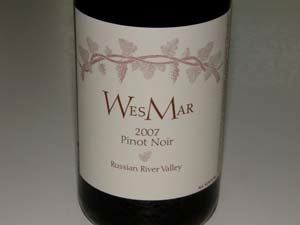 2007 WesMar Russian River Valley Pinot Noir 14.2% alc., 268 cases, $35. A blend of the WesMar Russian River Valley vineyard designates. · Slight haze. Enticing aromas of spiced cherries, forest floor, sandalwood and a bit of floral scent. Medium-weighted core of tasty cherries, strawberries and raspberries with a hint of spice. Supple tannins and lively balancing acidity. Stylish, smooth and elegant. Not quite the mid-palate intensity and complexity of the other wines in the lineup, but a delightful wine in its own right. Very good.
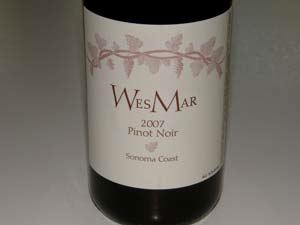 2007 WesMar Sonoma Coast Pinot Noir 14.2% alc., 316 cases, $35. Primarily a blend of Hellenthal and Balletto vineyards. · Intense, fruity nose featuring black cherries, black raspberries, a hint of spice and sandalwood. Too bad there isn’t a way to bottle this scent as an aphrodisiac. Rich, vivid and juicy black cherry bombast with Moroccan spices clothed in velvety tannins. The wine delivers a well-structured midpalate hit of dark fruit that is tenacious and persistent on the finish. This one has the whole package for me.
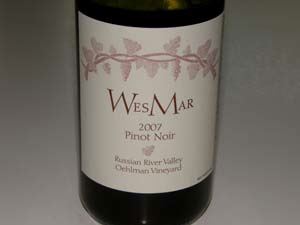 2007 WesMar Oehlman Vineyard Russian River Valley Pinot Noir 14.2% alc., 267 cases, $37. The Oehlman family has farmed their land on Vine Hill Road for five generations. The vineyard is planted to the Martini clone of Pinot Noir. · Alluring aromas of cherries and berries, potpourri and spring flowers. Intense, slightly confected cherry-berry flavors, even a hint of candied apple with cinnamon spice. A touch of citrus pulls the wine into focus. Seamless and elegant and the most feminine wine in the lineup. Often one of my favorite WesMar bottlings and this year is no exception.
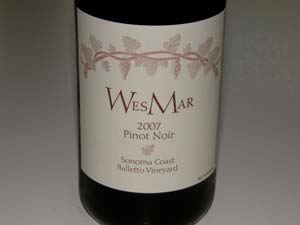 2007 WesMar Balletto Vineyard Sonoma Coast Pinot Noir 14.1% alc., 255 cases, $40. · Copious black cherries and olallieberries are dominant accented by a hint of oak, barnyard and Middle Eastern spice on the enticing nose. Luscious and generous on the palate tasting of a perfectly ripe dark cherry. Gossamer tannins make for a silky mouth feel and easy drinkability. Finishes with an endless echo of scent and fruit. I could still taste this wine the next day. If I had to pick just one in the lineup, this would be my paramour.
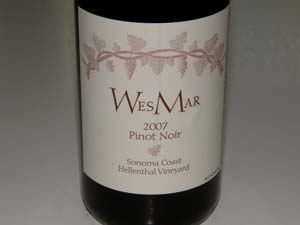 2007 WesMar Salzgeber Vineyard Russian River Valley Pinot Noir 14.4% alc., 129 cases, $45. · This wine shows the earthy side of WesMar and is typical of this vineyard. Lovely scent of cherries, herbs, and oak spice. Earth-kissed dark stone fruits with a moderate tannic edge suggesting age ability. Smoothly textured with a very long finish that has oak adding spicy layers to a satisfying conclusion. Very good.
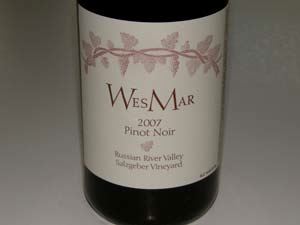 2007 WesMar Hellenthal Vineyard Sonoma Coast Pinot Noir 14.5% alc., 262 cases, $50. · Darkest in color in the glass. Attractive aromas of blackberries, dark plum, mocha and seasoned oak. On the palate the wine is well-structured, displaying mouth-coating plum and dark berry fruits with underpinnings of dark chocolate and loamy earth. The fruit is brooding initially, but picks up character and charm with time, changing like a chameleon in the glass. The velvety texture is very sensual. This wine demands contemplation. Very good (+).
Aubin Cellars has VerveAubin Cellars is a boutique producer of Pinot Noir, Syrah, Sauvignon Blanc, French Colombard and Gewürztraminer under the “Verve” label based in Oakland, California. The name, Verve, translates literally as “crafted with enthusiasm, vigor and integrity.” Verve is also a bilingual French-American noun reflecting the bicultural background of Aubin Cellars’ proprietor, Jérôme Aubin. French-born Aubin is an importer of artisan oak barrels from Tonnellerie Rousseau of Burgundy, Tonnellerie Saint-Martin of Bordeaux, Tonnellerie Allary of Cognac, A&K Cooperage of Missouri, and Balazs Cooperage of Hungary. He also imports wine concrete tanks from Nomblot of Burgundy and Lejeune Wine Tanks. The Verve label was founded in 2001. Aubin uses the talents of several winemakers including Loren Tayerie, previously with David Bruce Winery and Rosenblum Cellars, for the California Pinot Noir bottlings, and Ray Walsh, formerly of King Estate and now with his own label Capitello, for the Oregon Pinot Noirs. The Verve Pinot Noirs have been consistently fine over the past few vintages and inexpensive considering the quality. The artwork on the distinctive labels is attractive. I recently sampled four of the 2007 vintage Verve Pinot Noirs released in July 2009. The wines are styled in an elegant fashion with admirable harmony, great pinotosity and are very approachable now. To acquire the wines, contact Marie Bourdillas at 510-339-0170 or e-mail her at marie@aubincellars.com (the website, www.aubincellars.com, does not have the 2007 wines available for purchase at the time of this issue). Most of the Verve wines are sold through a mailing list.
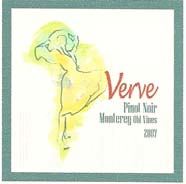 2007 Verve Monterey Old Vines Rio San Lucas Vineyard Monterey County Pinot Noir 14.5% alc., 98 cases, $24. 100% de-stemmed but not crushed. Fermented in T-bins. Manual punch downs. Minimal cold soak and 12 days average cuvaison. Aged 18 months in French oak barrels, 25% of which were new from Tonnellerie Rousseau. Bottled unfined and unfiltered. · A dark and intriguing wine. Aromas of black grapes, plums and seasoned oak are penetrating. Delicious tastes of black cherry, black currant, black raspberry and plum. Well-structured with ripe tannins, but not the least bit tannic. Really blossoms with time in the glass. Very good (+)
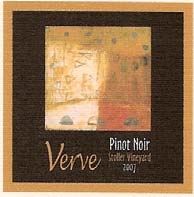 2007 Verve Stoller Vineyard Dundee Hills Willamette Valley Pinot Noir 13.5% alc., 150 cases, $30. Yields 1.9 tons per acre average. 100% de-stemmed but not crushed. Fermented in 2 ton French oak open top fermenter. Manual punch downs. Minimal cold soak and average cuvaison of 12 days. Aged 18 months in 40% new Rousseau and Saint- Martin barrels. Bottled unfined and aged an additional 5 months in bottle. · Aromas of red cherries, strawberries and smoky oak. The flavors echo the aromas. Light, elegant, soft and smooth with a good spark of acidity. A bit dilute which is reflective of this vintage in Oregon. Decent, but not nearly as impressive as the 2006 version of this wine.
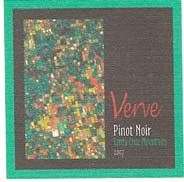 2007 Verve Klein Family Vineyard Santa Cruz Mountains Pinot Noir 94 cases, $33. Yields 1.5 tons per acre average. Clones 115 and 667. 100% destemmed but not crushed. Fermented in T-bins. Manual punch downs. Minimal cold soak and 12 days average cuvaison. Aged an average of 19 months in French oak barrels, 25% new from Tonnellerie Saint-Martin. Bottled unfined and unfiltered. · Initially the scents of fresh dark strawberries and black cherries dominate. With time in the glass, the fruit takes on a gregarious spicy tone with a hint of root beer. The core of powdery tannins is wrapped in layers of earth-dusted cherry and berry fruit. Light on its feet, gently styled, very smoothly textured, and showing perfect harmony. Very good (+)
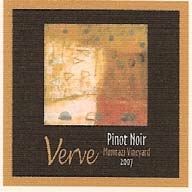 2007 Verve Momtazi Vineyard McMinnville Willamette Valley Pinot Noir 13.5% alc.,150 cases, $33. Yields 2.2 tons per acre average. Pommard and 777. Biodynamic farming. 100% de-stemmed but not crushed. Fermented in one Rousseau 2-ton French oak open top fermenter. Manual punch downs. Minimal cold soak and average cuvaison of 12 days. Aged 18 months in 40% new French oak from Tonnellierie Rousseau. Bottled unfined and aged an additional 5 months in bottle. · On the nose there are darker-toned fruits with notes of pepper and forest floor. Tasty core of dark berry fruit elegantly presented with supple tannins. More body than the Stoller bottling and more persistence on the finish. A feminine wine that delivers a good dose of charm. Very good.
A Short History of Pinot Noir in North America: The Formative Years 1850-1989The true origins of Pinot Noir are open to speculation. The Roman agronomist Columella identified vines and tasted wine in the First century AD and his descriptions seem to be consistent with what we call Pinot. It has been theorized that the Greeks and Romans took cuttings of Vitis vinifera which had originated in Transcaucasia (modern Turkey, Iraq and Iran) and imported the wild vines to France. Other historians argue that the first Pinot Noir vine appeared between the Third and Fifth centuries AD from a single mother vine in Burger, close to Burgundy. Thus, the original Pinot Noir vines may have been domesticated wild vines that originated in Europe. Regardless of its origins, we know Pinot Noir eventually made its way to the New World and that is where the Short History of Pinot Noir in North America begins. 1619 - Lord Delaware introduced the first European grapevines to North America. The French grapes could not be successfully grown due to susceptibility to phylloxera and other diseases. 1767 - The first European varietals were brought to California by Spanish Padres from Mexico. The primary grape variety planted in California was the Criolla or Mission grape which produced wines of poor quality. 1850-1856 - The first importer of Pinot Noir to California was either Frenchman Pierre Pellier, Colonel Agoston Haraszthy de Mokesa, founder of Buena Vista Winery, or Charles LeFranc, who immigrated from France in 1850 and founded New Almaden Vineyards. (source: North American Pinot Noir) 1880 - Gustav Niebaum planted Pinot Noir at Inglenook, the basis of the Martini clones of Pinot Noir. Inglenook made Pinot Noir-based Burgundy before Prohibition. 1880s - The Stanly Ranch in Carneros, with over 300 acres, was one of the largest vineyards in California and had significant Pinot Noir plantings. 1889 - Eugene Hilgard of the University of California planted Pinot Noir in the Sierra Nevada Foothills near the town of Jackson, the source of the Jackson clones of Pinot Noir. 1890s - Lucien Charles Tamm, a French homesteader, first planted wine grapes southeast of Soledad. 1920 - Francis William Silvear planted Pinot Noir southeast of Soledad near Tamm’s plantings. 1930s - Fountaingrove Winery north of Santa Rosa grew or is said to have grown Pinot Noir. A 1935 vintage wine was labeled Sonoma Pinot Noir. 1940s - Chafee Hall’s Hallcrest Vineyards in the Santa Cruz Mountains was one of California’s first boutique wineries. 1942 - Louis M. Martini bought 200 acres of the Stanly Ranch in Carneros and with Harold Olmo did extensive clonal experiments with Pinot Noir and Chardonnay. This research led to the UCD clone 108 for Chardonnay and UCD clones 12 and 15 for Pinot Noir. 1946 - Pinot Noir vines were planted at Chalone. The source and identity of the scion material is unknown. This was the oldest producing block of Pinot Noir in North American until it was pulled out several years ago. Andre Tchelistcheff, who some have called America’s greatest winemaker, crafted the 1946 Beaulieu Pinot Noir, a benchmark wine for Pinot Noir from California. 1945-1949 - Martin Ray planted Pinot Noir at Mount Eden and made Pinot Noir throughout the 1950s and 1960s. Martin Ray was the first high-profile boutique California winery and the first to produce a 100% Pinot Noir varietal table wine in California. 1953 - The Zellerbachs planted six acres of Pinot Noir in Sonoma Valley and produced the first vintage of Hanzell Pinot Noir in 1957. The original 4.04-acre Pinot Noir block is now called Ambassador’s Vineyard and is the oldest continuously producing vineyard of Pinot Noir (and Chardonnay) in California. The Pinot Noir scion is from Martin Ray. Late 1950s - Van der Kamp Vineyard, located near the top of Sonoma Mountain at 1,200 feet, was planted to Pinot Noir. It has been written that the vineyard contains the oldest block of Pinot Noir in Sonoma County, but most believe Hanzell’s 1953 block is the oldest. 1959-1961 - Pinot Noir planted by Konstantin Frank in the Finger Lakes region of New York. These blocks are older than all California plantings still in production except the 1953 block at Hanzell. The scion is clone 7 (Dr. Frank clone) which came through Maryland from Europe. 1964 - The Bacigalupi family planted Pinot Noir on Westside Road in the Russian River Valley using budwood from the Wente brothers. David Bruce, M.D. bonded his namesake winery and later made his first commercial Pinot Noir in 1966. Stanley Hoffman, M.D. planted 60 acres of vines including the only Pinot Noir at the time in the Paso Robles area. The scion material was from Mount Eden (then owned by Martin Ray). Hoffman’s Pinot Noirs gained recognition in the 1970s. The vineyard is now farmed as the HMR Estate Vineyard and Pinot Noir from this vineyard has been bottled by Adelaida Winery since 1996. Uriel Nielsen and Bill De Mattei planted Pinot Noir among more than 100 acres of vineyards known as the Nielsen Vineyard in the Santa Maria Valley. This was the first commercial vineyard in Santa Barbara County and is now part of Byron Vineyard & Winery. 1966 - David Lett was the first to plant Pinot Noir (and Pinot Gris) in the Dundee Hills of the Willamette Valley of Oregon when he started The Eyrie Vineyards. Charles Coury also planted Pinot Noir about this time in Forest Grove in the Willamette Valley. 1967 - Knudsen Erath established by Cal Knudsen and Dick Erath in the Willamette Valley. 1968 - Rodney Strong planted the River East Vineyard which included 19 acres of Pinot Noir adjacent the winery in Healdsburg. Joe Rochioli planted the East Block of Rochioli Vineyard in the Russian River Valley to Pinot Noir. The scion is unclear, apparently from a vineyard south of St. Helena in Napa Valley. The West Block was planted in 1969 using French clones from Joe’s friend, Carl Wente. Wilton (Tony) Husch planted the first Pinot Noir in the Anderson Valley in Philo. The Miller family purchased the 35,000-acre Rancho Tepusquet from the Allan Hancock family and planted 640 acres of Chardonnay, Merlot and Pinot Noir at Bien Nacido Vineyard in 1972. 1969 - Joseph Swan ripped out his estate field blend vineyard and planted Pinot Noir and Chardonnay. The property was in the Vine Hill region of the Russian River Valley, now known as Laguna Ridges. At least some of the budwood was from Mount Eden.
 1970 Dick and Nancy Ponzi planted their original 11-acre vineyard in Beaverton, Oregon. Maresh Vineyard was planted in the Dundee Hills, now the third oldest producing Pinot Noir vineyard in the Willamette Valley. Carneros Creek Winery founded in Carneros by Francis Mahoney, the first winery in Carneros after Repeal. Mahoney conducted the landmark Carneros Creek Winery Pinot Noir Clonal Trial from 1975 to 1985 and Phase 3 of the trial is still ongoing. 1970s - Robert Mondavi Winery was heavily into Pinot Noir but a landmark Pinot Noir was never produced. Archibald Vineyards, Shafer Vineyards, Tualatin, Elk Cove, and Amity Vineyards planted in the early 1970s in Oregon. Plantings of Rich and Claudia Smith at Paraiso Vineyards, Nicky Hahn at Smith & Hook, the McFarland family at Sleepy Hollow Vineyard, and Phil Johnson at La Estancia, all in Monterey County in the early 1970s. Sokol-Blosser, Bethel Heights, Adelsheim, Henry Estate, Arterberry, and Chateau Benoit launched in Oregon between 1975 and 1980. 1971 - The original Iron Horse Vineyard was planted to Pinot Noir and Chardonnay between 1971 and 1973. Located in the Green Valley of the Russian River Valley, Iron Horse was bought by the Sterlings in the mid 1970s and they released their first still Pinot Noir in 1979. The original winemaker and winegrower was Forrest Tanzer. The 90-acre Camelot Vineyard and the 533-acre Katherine’s Vineyard planted in the Santa Maria Valley on Santa Maria Mesa Road. The first significant planting in the Sta. Rita Hills was the Sanford & Benedict Vineyard planted in 1971 (Richard Sanford planted cuttings in 1970, grew them into rootings, and planted them in the Sanford & Benedict Vineyard in 1971). Sanford made a modest amount of wine in 1975 but the first commercial Pinot Noir produced from the Sta. Rita Hills was the 1976 Sanford Sanford and Benedict Vineyard Pinot Noir which was critically acclaimed by Dan Berger and others, as the first California Pinot Noir that was Burgundian in style. Pierre Lafond, who opened the first winery in Santa Barbara County since Prohibition (Santa Barbara Winery in downtown Santa Barbara), planted 65 acres in the Sta. Rita Hills and built a winery on the property (Lafond Winery & Vineyards). Pinot Noir came later. First viable Pinot Noir crop from Rochioli Vineyard sent to a co-op crush facility for Gallo in Windsor. 1972 - Norman Goss planted the Chamisal Vineyard in San Luis Obispo County. Pinot Noir was made under the Domaine Alfred label beginning in 1998. Davis Bynum bought the 84-acre River Bend Ranch on Westside Road in the Russian River Valley. He transformed a run-down hops kiln into a winery in time for his first release in 1973. Paragon Vineyard planted by Jack Niven, Edna Valley’s first large commercial vineyard. New partners acquired the Martin Ray Estate and produced their first vintage of Pinot Noir from 29-year-old vines. They renamed the Martin Ray property Mount Eden Vineyards. Merry Edwards made her first Pinot Noir at Mount Eden Vineyards in 1973. 1973 - Olivet Lane Vineyard planted to Pinot Noir and Chardonnay in the Russian River Valley by the Pellegrini family. Joseph Swan released his first Pinot Noir. Davis Bynum released a Rochioli Vineyard Pinot Noir from vines Rochioli had planted in 1968. This was the first vineyard-designated wine ever made in the Russian River Valley. Tom Dehlinger bought a parcel on Vine Hill Road, planted Pinot Noir in 1975, and made his first Pinot Noir at Joseph Swan’s winery in 1977. Mike Bohan became the first modern winegrower to farm Pinot Noir in the true Sonoma Coast. 1975 - Cecil DeLoach planted his first Pinot Noir in the Russian River Valley on land he had bought in 1969. Randall Grahm started Bonny Doon with the intention of producing Pinot Noir in the Santa Cruz Mountains. His results were so disappointing that he budded over his vineyard to Rhone varieties in 1985. Ken Burnap acquired his Vine Hill property, named it Santa Cruz Mountain Vineyard, and released his first Pinot Noir. Josh Jensen planted his first three Pinot Noir vineyards after establishing Calera Wine Company in 1974 on Mt. Harlan, Hollister, California. Calera is located just south of Chalone in the same Gavilan Mountain Range in San Benito County.
 1978 - Navarro Vineyards in Anderson Valley released their first estate bottled Pinot Noir. Babcocks bought 110 acres on Hwy 246 in what is now the Sta. Rita Hills AVA. They initially made Pinot Noir from purchased grapes, planting their own Pinot Noir vineyard in 1986. 1979 - Kistler Vineyards launched in the Russian River Valley. Williams Selyem born in a garage winemaking project (Hacienda del Rio from 1979 to 1984). Acacia Winery debuted in Carneros with Larry Brooks as winemaker. Chalone Vineyard and Paragon Vineyard formed a partnership and established Edna Valley Vineyard. 1980 - David Hirsch planted his first 3 acres of Pinot Noir in Cazadero, close to Mike Bohan’s original plantings in the true Sonoma Coast. First planting of Pinot Noir in Marin County by Mark Pasternak of Devils Gulch Ranch in Nicasio. UCD 15 (Martini Clone) on AXR. 1981 - Saintsbury founded in Carneros. The first vineyard was planted adjacent the winery in 1986. Saintsbury was the first California winery to make Pinot Noir totally from Dijon clones. Thomas Fogerty Winery bonded. The first 2 acres of Pinot Noir were planted adjacent the winery in the Santa Cruz Mountains in 1983 and a second 5 acres of Pinot Noir were planted in 1984. Sanford Winery established in the Sta. Rita Hills AVA. Santa Maria Valley AVA approved (amended in 1985). Dijon clones of Pinot Noir were first planted in Santa Barbara County in the Santa Maria Valley. 1981-1982 - Christine Woods, Claudia Springs, Pepperwood Springs, Schraffenberger Cellars, Handley Cellars and Roederer were established in the Anderson Valley. 1982 - Gary Farrell made his first commercial wine, a blend of Rochioli West Block and Three Corner Block grapes from the Rochioli Vineyard. Joe Rochioli had Gary Farrell make 150 cases of Rochioli Pinot Noir to launch the Rochioli brand. A winery was completed on the property in 1985. Etude founded by Tony Soter in Carneros. Pisoni Vineyard planted by Gary Pisoni in the Santa Lucia Highlands of Monterey County. Jim Clendenen founded Au Bon Climat. Robert Stemmler released his first Pinot Noir and this wine garnered more awards than any other wine in America for a first-release Pinot Noir. He was also the first to produce a Sonoma Coast Pinot Noir, long before it became a well-known appellation. 1983 - Willamette Valley AVA, Anderson Valley AVA, Russian River Valley AVA, and Carneros AVA approved. Burt Williams and Ed Selyem began making wines under the Williams Selyem label in a rented garage on River Road in Fulton in the Russian River Valley. Willamette Valley Vineyards started by Jim Bernau in Turner, Oregon. Robert Parker, Jr., launches 100-point scoring system. 1984 - Ken Brown and partners founded Byron Vineyard & Winery in the Santa Maria Valley. Brown was one of the first to realize the potential for Pinot Noir in Santa Barbara County. Dr. Raymond Bernard, one of the developers of clones in Burgundy and regional director of the Office National Interprofessional des Vins (ONIVINS) in Dijon, France, sent to Oregon Pinot Noir clones 113, 114, 115, and in 1988, 667 and 777. Together they became known as the Dijon clones and all are descended from individual plants that grow in vineyards belonging to Jean-Marie Ponsot of Morey-St.-Denis. Dr. Bernard’s donation had a significant influence on the success of Oregon and California Pinot Noir. 1986 - Jackie and Michael Etzel, along with their in laws, Patricia and Robert Parker, Jr., decided to grow grapes on top of Ribbon Ridge in the Chehalem Valley of Oregon. In 1988, they launched their own label, Beaux Freres, meaning brothers-in-law. Judy Jordan founded J Vineyards & Winery as a small methodé champenoise sparkling wine project. 1987 - Domaine Drouhin bought land in the Dundee Hills of the Willamette Valley. Planting began in 1988 and Domaine Drouhin was the first to plant Dijon clones of Pinot Noir in Oregon. The first International Pinot Noir Celebration was held in McMinnville, Oregon. 1988 - Santa Lucia Highlands AVA approved. 1989 - Shea Vineyard was planted by Dick Shea and partners in what is now known as the Yamhill-Carlton AVA in the heart of Oregon’s Willamette Valley. Loma Prieta earthquake destroys a number of vineyards and wineries in the Santa Cruz Mountains.
Small Sips of Russian River Valley PinotAthair Wines Athair means “father” in Irish Gaelic. The label is a collaboration between Tom Keith and his son-in-law, Jim McMahon. McMahon learned his winemaking at Kenwood Winery in Sonoma Valley, and subsequently at Luna Vineyards in Napa Valley where he is currently the assistant winemaker. Jim McMahon crafts this wine in memory of the fathers in his life. Visit the website at www.athairwine.com.
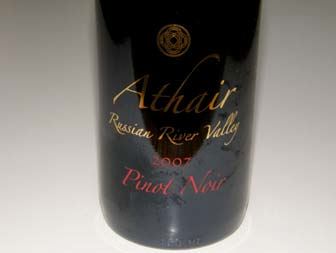 2007 Athair Russian River Valley Pinot Noir 14.7% alc., 725 cases, $36, unreleased. Grapes sourced from Calegari Vineyard on Eastside Road and Lowe Vineyard on River Road. Aged in 30% new and 70% neutral French oak barrels. · Complex and appealing nose featuring aromas of Bing cherries, cardamon spice, a hint of oak, and a little good funkiness. Cherry-driven with an underpinning of cola and spice with a memorable persistence of cherry fruit on the finish. Nicely put together and a pleasure to drink. Very good.
Dehlinger Winery In a recent issue of the PinotFile, I featured an in-depth story on Dehlinger which included a vertical tasting of Dehlinger Estate Russian River Valley Pinot Noir from 1996 to 2006. Since that review, I was able to locate the 1997 vintage which was missing from the vertical.
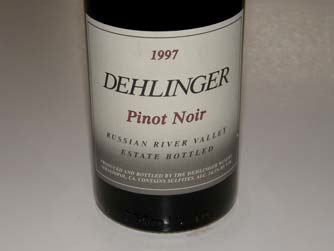 1997 Dehlinger Estate Russian River Valley Pinot Noir 14.5% alc., 1,300 cases, $35. · Still bright in color. Lovely scents of black cherries, cedar, old oak and prominent spice. A well-structured and thoroughly delicious wine that is surprisingly fresh for its age. Rich and satisfying flavors of black raspberries, cherries, grilled fruit, charred wood and brown spice are framed by soft tannins and bright acidity. This wine has character and staying power. It will last several more years. Who says California Pinot Noir can’t age?
The Donum Estate The Donum Estate is devoted to a single Carneros estate Pinot Noir and a Russian River Valley estate Pinot Noir. The name Donum translates from the Latin to “gift,” and refers to grapes as a gift of the land. Winegrower and President, Anne Moller-Racke, was the vineyard manager for Buena Vista Carneros for many years and played an instrumental role in obtaining appellation status for Carneros and the formation of the Carneros Quality Alliance. With the sale of Buena Vista to Allied Domecq in 2001, the Racke family of Germany split off 200 acres of the Buena Vista Estate to form The Donum Estate as well as to grow grapes for the revived Robert Stemmler label. The consulting winemaker for The Donum Estate and Robert Stemmler is talented Kenneth Juhasz (his own label is Auteur) and the assistant winemaker is John Harley. The Russian River Valley bottling comes from the 11-acre Nugent Vineyard which is farmed by the Donum Estate.
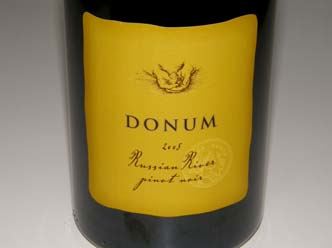 2005 Donum Russian River Valley Pinot Noir 14.5% alc., 200 cases, $65. Inaugural Russian River Valley release. Remarkably long 130 day hang time. 100% de-stemmed. 5-day cold soak, native fermentation, aged on lees for 11 months in 75% new French oak. · Dark reddish-purple color. The aromas of black cherries, black raspberries and woodshed draw you in. Very tasty raspberry and blackberry attack with a hint of cola and brown spice. A charming wine that has aged beautifully. Nicely proportioned, soft in the mouth with supple tannins. Perfect now. Very good.
2006 Donum Russian River Valley Pinot Noir 14.4% alc., $65. 95% de-stemmed. 5-day cold soak. Native fermentation. Aged on the lees 11 months in 75% new French oak. · Aromas of black cherries, plums, wildflowers, oak and a slight green note. Well-endowed core of blue and black fruit with accents of earth, mocha and cola. Robust and succulent but well defined by balancing soft tannins and lithe acidity. Pretty good but not exceptional. Very good (-).
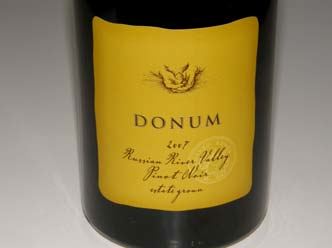 2007 Donum Russian River Estate Grown Pinot Noir 14.4% alc., pH 3.69, 500 cases, $65. 40% 667 and 60% 115. 95% de-stemmed. 5 to 10 day cold soak, native fermentation, 1 week extended maceration, aged on lees 11 months in 75% new French oak. No press wine incorporated into the blend. Unfined and unfiltered. (Label says 100% Carneros fruit from Donum Estate - obviously an error). · Dark reddish-purple color. Very lovely black cherry and blackberry aromas that are heady and penetrating. Full-bodied, almost syrupy, with endless dark Pinot fruit. Unusually dark for Russian River Valley stock. Still backward and linear without nuance but definitely has impressive stuffing. The best Donum Russian River bottling to date. Put this one in the cellar. Very good.
Dutton Estate WineryThis winery specializes in vineyard-designated Pinot Noir, Chardonnay, Syrah and Sauvignon Blanc from the Dutton family’s estate vineyards at Dutton Ranch in the Green Valley, Russian River Valley and Sonoma Coast appellations. Established in 1995 by Tracy and Joe Dutton as Sebastopol Vineyards, winemaker Mat Gustafson crafts the Dutton Estate wines as well as those released under the Sebastopol Vineyards label which are a broader representation of the appellations. Gustafson has been the winemaker since 2002. The Dutton Ranch was founded in 1964 by noted Sonoma County viticulturist Warren Dutton. Today, Dutton Ranch farms 1150 acres of grapes and 150 acres of apples. The wines are available on the website at www.duttonestate.com and through retailer www.klwines.com. A 2007 Manzana Vineyard Pinot Noir and 2007 Jewell Block Pinot Noir are also available.
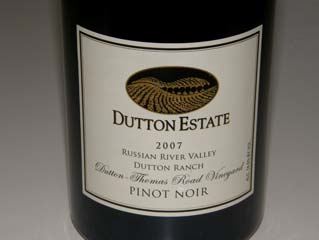 2007 Dutton Estate Dutton Ranch Dutton-Thomas Road Vineyard Russian River Valley Pinot Noir 14.5% alc., 275 cases, $45. · Lovely aroma of fresh cherry tart. Red cherry and berry fruit is front and center with a touch of earthiness. Very supple in the mouth with well-concealed tannins and impeccable balance. More finesse and less persistence than the Karmen Isabella bottling, but very satisfying in its own right. Very good.
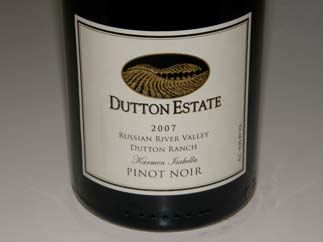 2007 Dutton Estate Dutton Ranch Karmen Isabella Russian River Valley Pinot Noir 14.9% alc., 625 cases, $37. Composed of fruit from three selected vineyards at Dutton Ranch in the Green Valley of Russian River Valley. · Stunning aromas of fresh Bing cherries and strawberries. Luscious core of cherries, strawberries and cassis create a rich and vivid middle palate. All silk and satin in texture with alcohol providing a sweet plushness. A hedonistic Pinot Noir that will please lovers of virile fruit. I usually go for a lighter touch, but this one really grabbed my attention.
EnRoute The Nickel Family (Far Niente, Dolce and Nickel & Nickel) has entered the Pinot game with the release of the 2007 EnRoute Les Pommiers Russian River Pinot Noir. Nickel & Nickel has quietly been producing a string of vineyard-designated Pinot Noirs in small quantities from the Dutton Ranch’s Manzana Vineyard and Spring Hill Vineyard in Petaluma. The success of these wines led to the establishment of a new label and winery exclusively devoted to Pinot Noir. The partners bought an old apple orchard and planted 21.5 acres to clones 115, 777, Pommard 5, Mt. Eden, Swan, and 2A (christened the Graton Vineyard), and acquired the 22-acre Amber Ridge Vineyard which is composed of clones 115, 667, 777, Pommard 5. The 2007 EnRoute Pinot Noir was primarily sourced from Manzana Vineyard, but beginning in 2008, the EnRoute Pinot Noir was sourced from the two estate vineyards and a small amount of Manzana Vineyard. The winemaker is Andrew Delos, a former assistant winemaker at Nickel & Nickel who previously worked with Russian River Valley fruit at Pellegrini Family Vineyards. Until a new winery is built, the EnRoute Pinot Noir is being produced in another winery facility in Graton. The winery’s art deco label is among the smartest labels I have ever seen. The EnRoute wines are highly allocated to a mailing list with limited restaurant and retail distribution. To acquire, visit the website at www.enroutewinery.com.
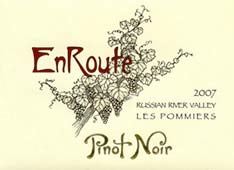 2007 EnRoute Les Pommiers Russian River Valley Pinot Noir 14.4% alc., 1,200 cases, $50. This wine is named for the apple orchards that once flourished in the Russian River Valley. Primarily Manzana Vineyard fruit, clones 114, 115 and Pommard 5 with a small amount of Sonoma Coast fruit. · Terrific nose showing off hi-pitched aromas of Bing cherries and raspberries with hints of oak-induced vanilla and spice. In the mouth, this wine has that lush cherry fruit the Russian River Valley is so noted for augmented by notes of cola and brown spices. The tannins are ripe and supple, and the smooth texture is captivating. An impressive debut that delivers a panoply of Pinot pleasure.
Gary Farrell Vineyards & Winery This winery still carries noted winemaker Gary Farrell’s name, but he has left to pursue his own label (Alysian). The winery is now owned by Ascentia Wine Estates. The picturesque winery is located on Westside Road, the Rodeo Drive of Pinot Noir, perched on a hillside overlooking the Russian River Valley. Winemaker Susan Reed was picked by Gary Farrell to continue his tradition of winemaking and the winery has maintained access to superb fruit sources in the Russian River Valley. The single vineyard and Russian River Valley Selection Pinot Noirs and Chardonnays are sold on the website at www.garyfarrellwines.com.
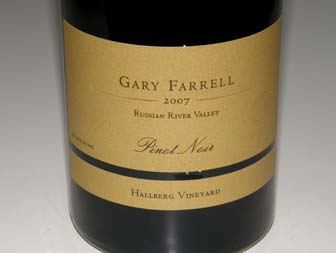 2007 Gary Farrell Hallberg Vineyard Russian River Valley Pinot Noir 14.2% alc., pH 3.43, 527 cases, $50. The 100-acre Hallberg Vineyard was named for its previous owners Don and Marcia Hallberg and today is owned by a group of investors headed by Brice Jones of Emeritus. 58% clone 777, 31% clone 667, 11% Pommard. The grapes were 100% destemmed, 5-day cold soak, inoculated with Assmanshausen yeast for primary fermentation. Aged in 55% new French oak barrels for 12 months. · Moderately dark reddish-violet color. Rich and pleasing aromas of black cherries, dark berries and crusty bread. On the palate there is a mix of Pinot fruits including cherries, black raspberries and plums with a hint of citrus on the finish. Earth, tea and cola notes add interest. The mouthfeel is very smooth, the dry tannins are reserved, and the wine shows admirable Pinot finesse. My only nit is that the wine lacks mid-palate impact and shows minimal finishing persistence, but these features should improve with another year or two in the bottle. Very good (-)
2007 Gary Farrell Russian River Selection Chardonnay 14.2% alc., pH 3.32, 6,677 cases, $32. Barrel fermented in 100% French oak barrels (33% new) for 7 months. · Straw colored. Scents of pear, melon and restrained oak. Moderately rich flavors of apple, pear, lemon and the slightest oak. Smooth and very slightly viscous with a nice grip of acidity. Decent (+).
Porter Creek Vineyards Porter Creek has a long history in the Russian River Valley, dating to 1977 when George Davis bought 40 acres of land adjacent Porter Creek on Westside Road. Porter Creek is one of the major tributaries to the Russian River. Porter Creek Burgundian and Rhone wines developed a loyal cult following over the years, but the winery has never achieved notoriety. The estate is planted to both Pinot Noir and Chardonnay. George Davis made the wines from 1982 until 1997, when his son, Alex Davis, took on that role. Alex has a degree in enology from California State University at Fresno and spent several years in France at such renowned wineries as Christophe Roumier, Bernard Michelot and Marcel Guigal. All estate vineyards are certified organic and in transition to Demeter biodynamic certification. The winemaking style employs natural fermentation exclusively, discreet use of new oak for elevage, and an emphasis on channeling terroir into the finished wines. The wines are sold through a mailing list and direct inquiry (707-433-6321, wwwportercreekvineyards.com).
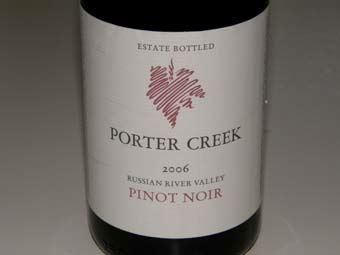 2006 Porter Creek Russian River Valley Estate Bottled Pinot Noir 14.3% alc., $32. · Intriguing notes of cherries, brier, sage, sawdust and oak on the nose. Earth-kissed black cherry core with grippy tannins that currently overwhelm the fruit. Improves in the glass over time indicating that decanting or further aging is advised. Hard to put my finger on it, but this wine just doesn’t excite now. Decent (+).
Sequana Vineyards Industry veteran Tom Selfridge recruited winemaker James MacPhail (MacPhail Family Wines) to create a new winery sourcing grapes from the Green Valley of Russian River Valley and the Santa Lucia Highlands. Sequana is the Franco-Roman goddess of the River Seine which flows through the ancestral birthplace of Pinot Noir. MacPhail, who mentored under Gary Farrell and Merry Edwards in the 1990s, handles all the viticulture duties as well. Three Pinot Noirs were released in 2007 (the Dutton Ranch Pinot Noir is not reviewed here). The wines are crafted in the same style as MacPhail Family Wines showing fruit-driven flavors, generous alcohols and well-extracted and well-structured body. The Pinot Noirs are sold on the website at www.sequanavineyards.com and through limited retail distribution. Impressive website.
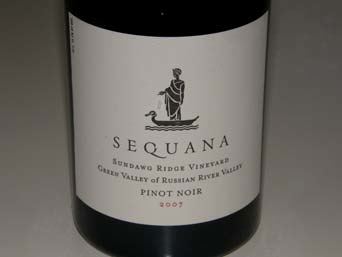 2007 Sequana Sundawg Ridge Vineyard Green Valley of Russian River Valley Pinot Noir 15.1% alc., pH 3.58, $50. This vineyard is planted in Goldridge soils over marine sedimentary sandstone and the site is heavily influenced by morning and evening fog. After cold soak, the grapes were fermented in small, open-top tanks using primarily native yeast. Hand punch downs. Aged on the lees in 40% new French oak for 11 months. · Leads off with aromas of black cherries, oak and mint. Dark cherries and berries are featured on the well-endowed palate with accents of earth, cola and oak. The fruit is encased in healthy, ripe tannins. The alcohol is well-integrated. May warrant a better rating in a year or two. Decent (+).
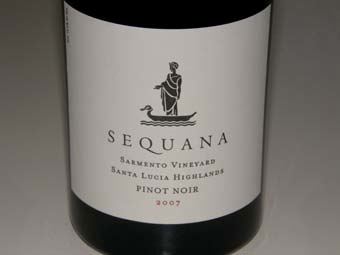 2007 Sequana Sarmento Vineyard Santa Lucia Highlands Pinot Noir 14.8% alc., pH 3.82, $32. · Winemaking regimen same as for Sundawg Ridge bottling. Heavily oaked fruit with an underpinning of earth and herbs on both the nose and palate. Smoothly textured with restrained tannins and a dry finish which leaves an unpleasant oak tug. Decent.
Tandem Greg La Follette is an icon among California winemaker circles. Educated at University of California Davis, he trained under wine masters such as Tchelistcheff and Kongsgaard and was one of the first winemakers bringing attention to the “true” Sonoma Coast (at Flowers). He has consulted on numerous new winery launches including Londer Vineyards and James Ball Vineyards, both in the Anderson Valley, and has contributed his expertise on the international stage as well. La Follette was recently the consulting winemaker at De Loach Vineyards. He has designed and redesigned fourteen wineries worldwide and was the consulting winemaker for the new University of California Davis teaching winery. His own Tandem label sources from vineyards that represent long-standing relationships. La Follette helped plant Keefer Ranch Vineyard when he was the winemaker at Hartford Court. He provided much of the bud wood for Van der Kamp Vineyard in Sonoma Mountain. La Follette has a long standing relationship with Sangiacomo vineyards. He was the first to recognize the potential of Ritchie Vineyard when he first brought grapes into Flowers several years ago. Recently, he has developed an interest in the Manchester Ridge AVA of Mendocino County. His style tends to be big and bold with wines that are well-oaked and initially tannic. They benefit from some cellar time after release. The wines are currently vinified in Sebastopol at the former Vacu-Dry apple processing plant. Tandem wines are available on the website at www.tandemwines.com and through retail distribution.
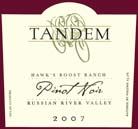 2007 Tandem Hawk’s Roost Ranch Russian River Valley Pinot Noir 15.1% alc., pH 3.69, 184 cases, $54. Entirely from Mariafeld clone (UCD 23). Aged 11 months in 40% new French oak. · Moderately deep garnet color. Oak char is prominent on the nose and obscures the underlying fruit. A well-endowed, generously extracted wine with a thick core of dark stone fruits, blackberries, beef and tar. Plenty of tannin still to shed. The alcohol is well hidden. The finish leaves an oak hangover. Will improve with time in the cellar, but will always be an oaky wine. Decent (-).
Commentary: It should be noted that in a recent Wine Spectator article, wine critic James Laube talked about the trend in California Pinot Noir to “pulling back with more modest alcohols.” Although this may be a perceived trend, my experience, as demonstrated by the wines above and others in the section to follow, is that there are still many Pinot Noirs in the marketplace with high alcohols, dark color, high extraction, and plenty of oak.
More Sips of California Pinot2008 Adrian Fog X Decade Anniversary Bottling Pinot Noir 14.5% alc., $75. Four of the best barrels in the cellar, two from Oppenlander Vineyard and two from a Sonoma Coast Vineyard. Native fermentation, free run juice only, unfined and unfiltered. Aged 11 months in new and seasoned oak. · The unpleasant nose is lacking in fruit with aromas of brier, oak char, oiled wood and ash in the forefront. Decent core of deep red berries, currants and plum with a citrus underpinning ending with a piercingly tart grapefruit peel finish. Definitely not worth the tab. Decent (-).
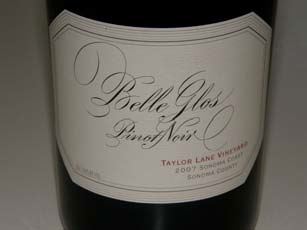 2007 Belle Glos Taylor Lane Vineyard Sonoma Coast Pinot Noir 14.6% alc., $40. · Dark purple color. Well-spiced black cherry and berry scent reminiscent of jam on toast. Rich middle palate of sweet cherries, berries and plums which is plush, even syrupy, but not jammy. A fruit driven wine with moderate dry grainy tannins that will find many fans. Take this handsome wax-dipped bottle (a tab is attached to the wax for easy opening) to a restaurant and you will get some attention. The best wine I have tasted from this producer to date. Widely distributed (under the Caymus family umbrella).
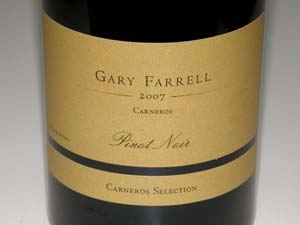 2007 Gary Farrell Carneros Selection Pinot Noir 14.4% alc., pH 3.46, 1,336 cases, $42. Sourced from 10 blocks of the Ramal Vineyard in the Carneros appellation. Clones 115, 777, 828, Pommard 5. 100% de-stemmed, 5-day cold soak, fermented in stainless steel tanks with regular punch downs. Aged in 37% new French oak barrels for 9 months before bottling. · Feral nose of barnyard, forest floor, and smoky oak. Understated cherry core with grilled meat, smoke and oak in the background. Silky and mildly tannic with bright acidity. A shy wine that is not particularly exciting. Decent.
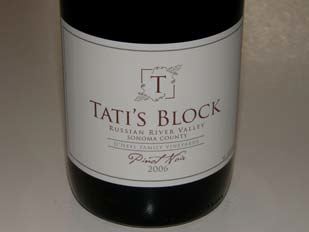 2006 Tati’s Block O’Neel Family Vineyard Russian River Valley Pinot Noir 14.5%, $25. This bottling is a private reserve wine of the O’Neel family who sell some of their fruit to Kosta Browne. · Moderately deep ruby color. Aromas of cherries, strawberries, herbs and toasty oak. Elegantly styled with admirable acidity and supple tannins. The wine is initially herbal and oaky but sampled the next day from a previously opened re-corked bottle, had become more fruity and lost its woody qualities. Decant or cellar for a year or two. Decent (+).
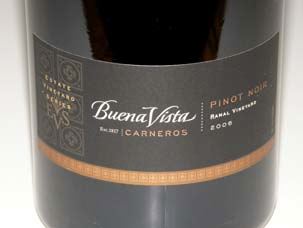 2006 Buena Vista Ramal Vineyard Carneros Estate Vineyard Series Pinot Noir 14.3% alc., pH 3.66, 4,047 cases, $38. Clones 115, 667, 777, 828, Pommard 5 and Swan. Grapes were de-stemmed, cold soaked 5 to 8 days, fermentation in 5- and 7-ton open-top fermenters, aged in 39% new French oak. · Moderately dark reddish-purple color. The nose really draws you in with aromas of ripe black cherries, vanilla, and a woodsy tone of forest floor and mushrooms. Discreetly concentrated cherry and berry flavors with some pomegranate, earth and oak toast in the background. Tangy and smooth on the finish leaving a pleasant impression of fresh cherries. Very good.
Don Sebastiani & Sons Branching OutIt is hard to keep up with all the different Pinot Noir bottlings under the umbrella of the negociant wine company, Don Sebastiani & Sons. Until recently, the main wine division of Don Sebastiani & Sons was the Three Loose Screws Wine Company which includes the popular Smoking Loon and Pepperwood Grove labels made from purchased bulk wine and selling for less than $10. In addition, Pinot Noirs have been released under The Crusher, Aquinas and Mia’s Playground labels, and represent a step up in quality and price. Last year Three Loose Screws Wine Company sold 1.7 million cases. The higher-end division of Don Sebastiani & Sons, The Other Guys, has been operating separately under the direction of the three children of Don and Nancy Sebastiani (Donnie, August and Mia), and includes Moobuzz Pinot Noir. The market for The Other Guys wines is directed at restaurants and retailers and sales are in the 110,000 case per year range. The Other Guys is an innovative brand, directed at millennial wine drinkers, including names such as Hey Mambo and Plungerhead and new packaging like screw caps and Zork closures. Their tag line says it all, “Laid-back guys, stand-out wines.” I love the idea. The wine has no tie-in with the upcoming movie, “The Other Guys,” starring Will Ferrell and Mark Wahlberg. Don Sebastiani & Sons is currently in transition and by the end of 2009, Don's two sons will each be in charge of his own company: The Three Loose Screws division will be discontinued and will become Don & Sons with The Other Guys operating as a separate stand-alone company. Both companies will be under the umbrella of Don Sebastiani Family Wines. The Sebastiani family feud is one of the most publicized in Sonoma County. In 1986, Sylvia Sebastiani fired her oldest son, Sam Sebastiani, and put her other son Don in charge. Sam Sebastiani started his own winery, Viansa, but it was not successful and was subsequently sold. Sebastiani Vineyards was also sold and Don launched his own company, Don Sebastiani & Sons, which has been very successful. The Pinot Noirs I have sampled from the two divisions of Don Sebastiani & Sons have been uneven, with some wines representing excellent value-priced examples of Pinot Noir, and others offering agonizingly poor quality. I am always interested in discovering well-priced quality Pinot Noirs for everyday drinking so I have sampled the Pinot Noirs of Don Sebastiani & Sons off and on through the years. Recently, I tasted two recent releases.
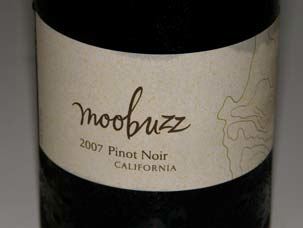 2007 moobuzz California Pinot Noir 13.5% alc., pH 3.76, $20 (retail, but often sold at $14-$15), yellow Zork closure. Topographic map of Monterey on the label where the grapes are primarily sourced. Best barrel lots from Monterey County in the 2007 vintage. Aged 10 months in French oak. · Initially a very bright perfume of cherries, strawberries and raspberries, leading to a smoky influence over time. Moderately rich core of berry fruit with a smoky overtone. Minimal tannins and easy to drink. Decent
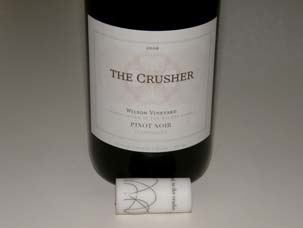 2006 The Crusher Wilson Vineyard Clarksburg Pinot Noir 13.5% alc., $12- $13, white synthetic cork closure. · The nose is composed of black fruits, herbs, oak and cedar. Moderately lush dark fruits create a plush mouth feel. Woodsy and earthy with some oak char in the background. Smoothly textured, this bold wine represents the dark, loamy side of Pinot Noir. Decent. The 2008 vintage is in current release but I have not sampled it.
Pinot BriefsGeologist Debunk Soil Impact on Wine? Not so fast. The Associated Press (AP) reported this week on the Geological Society of American conference in Portland, Oregon. The news report chimed, “Debunking mistaken notions of terroir was one of the goals of the scientists during the meeting.” It went on to say, “Geologists say wines may vary in levels of dissolved minerals, but those variations aren’t related to the levels in vineyard soil. The concentration of minerals in wine is below the threshold of human taste and smell. Whatever ‘minerality’ in wine is, it is not the taste of vineyard minerals.” In a communique I received from Damien Casten of Candid Wines in Chicago, he sent to me this response from noted Oregon geologist, Greg Jones. “I was at the meeting (a very good session in my opinion) and gave two talks. Even what I said was taken out of context in the AP story as was much of everything else. There was no ‘debunking,’ only good debate about the relationships between climate, landscape, soil and vine. The take home was that it is clearly a non linear issue we know virtually very little about, but that the use of terms like ‘minerality’ are overdone and have no connection or basis for being derived directly from some mineral aspect in the soil. It never stated that soil has no impact on wine. To the contrary, the take-home for me confirmed what I truly believe: geology, landscape and soil are important factors that mediate the interaction between climate and the vine, especially soil water supply and nutrition. Climate is most basic and most profound for what can be grown where and how. For me this gets back to the sense of place or the importance of site being at the core of terroir!”Toss Those Heavyweight Bottles Sure those heavy bottles with large punts are impressive and make a statement, but I hate them. They don’t fit into my cellar racking, they are awkward to manage, and they are increasing our carbon footprint. I am not alone. Tim Atkin wrote in The Observer (October 25, 2009), “Anyone who makes an icon wine seems to come over all macho and purchase the thickest glass available.” Atkins, who is a wine critic for the UK newspaper, has vowed to not recommend any wines that come in a heavyweight bottle. The only exception is Champagne and sparkling wine where the packaging must be resistant to the high pressures of the wine inside. Read his remarks at www.timatkin.com. By the Numbers Number of wineries in California: 2,843. Number of wine grape growers in California: 4,600. Number of varieties of wine grapes grown in California: >110. Number of bottles produced with one ton of California wine grapes: 797 (about 66 cases). Number of bottles produced by one grapevine: approximately 5. Number of results from Googling California wine: 23-46 million. Number of people who visit California wine regions every year: 20.7 million. Number of wine companies that represent more than 90% of U.S. wine market by volume: 30. Percentage of wine buying market that buy wine over $25: 2%. Number of wine blogs on the internet: over 700 (570 in English).
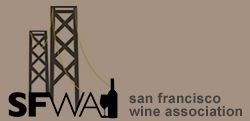 San Francisco Wine Association This is a consortium of 20 boutique, family owned wineries that produce wine in San Francisco. SFWA member wines are available for sale at www.sfwineassociation.com, and the association pours at events in the San Francisco Bay Area. The second annual SFWA Holiday Showcase at Crushpad in San Francisco will be held on Thursday, December 10, from 5:30 to 8:00 PM ($25). Several of the wineries produce or even specialize in Pinot Noir including Bartz-Allen Winery, Connor Brennan Cellars, Damian Rae Winery, Due Cani Cellars, Joelle Wine Company, Kindred Wines, Mark Moretti Winery, Millarium Cellars, PerryMoore Wine, Seawind Wines, Pug Wine, Think Tank Wine Company, Townley Wines, and Wait Cellars. I haven’t sampled many of the Pinot Noirs from these producers but plan to do a tasting soon. Stay tuned. Other notable independent producers of Pinot Noir in San Francisco are A.P. Vin, August West, and Harrington Wines. Wine Tasting Palate Cleanser SanTásti is a sparkling carbonated beverage formulated to refresh the taste buds between sips of wine. Supposedly, SanTásti helps remove tannins and stimulate saliva flow to leave the mouth with a clean feeling. The drink is slightly sweet and citrusy but has no aftertaste. It is available in classic, peppermint and cinnamint flavors. SanTásti is distributed throughout California. For more information, visit www.santasti.com. Iron Content of Red Wine Influences Compatibility with Seafood In a study published in the Journal of Agricultural and Food Chemistry, it was found that red wines with high levels of iron caused a strong fishy aftertaste with seafood (scallops in the research study), while white wines did not. When a substance was added to the red wine to bind iron, the exaggerated fishy taste cause by the red wine disappeared. Red wines with lower iron levels would be potentially better matches for fish, but in my limited research I could not find any information on the relative iron levels of different commonly consumed red wine varietals.
Book Review: Is This Bottle Corked?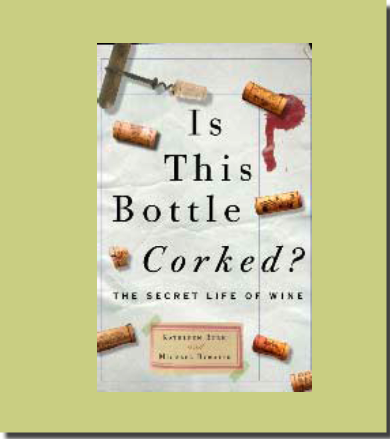 This is just the kind of off beat book about wine that you might find very interesting. No chapters about what to drink, how to drink, how to match food with wine, and other tiresome wine preaching. Rather, this book offers 138 somewhat obtuse but fascinating questions about wine. The authors, Kathleen Burk and Michael Bywater, are not wine gurus or critics, but rather wine lovers who have an interest in the historical perspective of wine. The result is a book with an academic tone, offering short and straightforward answers that fascinate rather than bore the reader. Examples of questions posed include, “What did Jane Austen recommend for headache?” (Answer: Constantia wine), “Did Benjamin Franklin really produce a ‘sprightly claret?” (Answer: He gave instructions on how to make wine in the Colonies in the 1743 edition of Poor Richard’s Almanac), “What was Napoleon’s favorite wine?” (Answer: Clos Vougeot and Chambertain), and “Was Pliny the first Robert Parker?” (Answer: No 100- point scale, but he was unrivaled as a wine scholar of his time). There are a number of other questions answered which will enrich anyone with an interest in wine such as, “Who first invented wine,” What is terroir, and should we care,” and “Should wine be decanted.” Because the short chapters are devoted to one question, the reader can pick up the book for short periods of time and thumb to a question of interest without reading the book from front to back. Wine writers will find the book a special resource of historical facts. The authors come from different backgrounds. Kathleen Burk is a Californian whose family were winegrowers and while at the University of California at Berkeley, she spent considerable time in the Napa Valley tasting wine. She is an accomplished author, has written for the World of Fine Wine, currently the world’s most sophisticated and highly lauded wine publication, but also is well-versed in history and a Professor of Modern and Contemporary History at University College London. Michael Bywater has written numerous articles for periodicals in the UK, is a regular broadcaster for the BBC, and teaches tragedy at the University of Cambridge. The pair’s diverse backgrounds and interests provide the right mix for a lively read about “The Secret Life of Wine.” Published by Random House, Inc., 208 pages, hardcover, 2009, $19.99. |